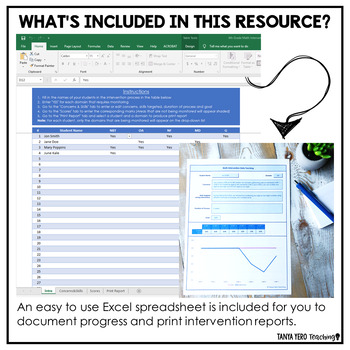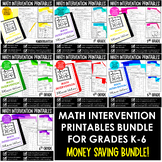6th Grade RTI Documentation Forms | Math Intervention Tracking Sheets
Tanya Yero Teaching
27.3k Followers
Grade Levels
6th - 7th
Subjects
Resource Type
Standards
CCSS6.G.A.1
CCSS6.G.A.2
CCSS6.G.A.3
CCSS6.G.A.4
CCSS6.SP.A.1
Formats Included
- Zip
- Excel Spreadsheets
Pages
25 pages
Tanya Yero Teaching
27.3k Followers
Also included in
- A comprehensive, no prep, standards-based bundle of RTI 6th grade math intervention resources. This research-based intervention bundle includes tools for building a systematic, data-driven intervention process.With pre/post-tests (for each domain) for executing screening, quick checks for progress mPrice $38.50Original Price $46.50Save $8.00
- A comprehensive, no prep, standards-based bundle of RTI math intervention resources for grades 6-8. This research-based intervention bundle includes tools for building a systematic, data-driven intervention process.With pre/post-tests (for each domain) for executing screening, quick checks for progrPrice $105.00Original Price $133.50Save $28.50
- A comprehensive, no prep, standards-based bundle of RTI math intervention resources for grades K-8. This research-based intervention bundle includes tools for building a systematic, data-driven intervention process.With pre/post-tests (for each domain) for executing screening, quick checks for progrPrice $299.00Original Price $395.00Save $96.00
- A comprehensive, no prep, standards-based bundle of RTI math intervention resources for grades K-6. This research-based intervention bundle includes tools for building a systematic, data-driven intervention process.With pre/post-tests (for each domain) for executing screening, quick checks for progrPrice $225.00Original Price $308.00Save $83.00
Description
Everything you need to track student progress and keep you RTI efforts organized!
This file includes printable graphs and recording sheets for every step of the math intervention process. This resource pairs perfectly with our 6th Math Intervention Bundle.
Use these forms to track RTI progress and provide documentation for parents and administration. There is a breakdown of how to use each form and tips and suggestions for filling each sheet out. There is also a digital option for tracking the intervention process provided in an Excel spreadsheet. Check out the preview to see more!
CLICK HERE to shop our line of intervention materials!
Total Pages
25 pages
Answer Key
Does not apply
Teaching Duration
1 Year
Report this resource to TPT
Reported resources will be reviewed by our team. Report this resource to let us know if this resource violates TPT’s content guidelines.
Standards
to see state-specific standards (only available in the US).
CCSS6.G.A.1
Find the area of right triangles, other triangles, special quadrilaterals, and polygons by composing into rectangles or decomposing into triangles and other shapes; apply these techniques in the context of solving real-world and mathematical problems.
CCSS6.G.A.2
Find the volume of a right rectangular prism with fractional edge lengths by packing it with unit cubes of the appropriate unit fraction edge lengths, and show that the volume is the same as would be found by multiplying the edge lengths of the prism. Apply the formulas 𝘝 = 𝘭 𝘸 𝘩 and 𝘝 = 𝘣 𝘩 to find volumes of right rectangular prisms with fractional edge lengths in the context of solving real-world and mathematical problems.
CCSS6.G.A.3
Draw polygons in the coordinate plane given coordinates for the vertices; use coordinates to find the length of a side joining points with the same first coordinate or the same second coordinate. Apply these techniques in the context of solving real-world and mathematical problems.
CCSS6.G.A.4
Represent three-dimensional figures using nets made up of rectangles and triangles, and use the nets to find the surface area of these figures. Apply these techniques in the context of solving real-world and mathematical problems.
CCSS6.SP.A.1
Recognize a statistical question as one that anticipates variability in the data related to the question and accounts for it in the answers. For example, “How old am I?” is not a statistical question, but “How old are the students in my school?” is a statistical question because one anticipates variability in students’ ages.









